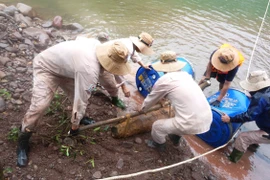Thecommittee noted that in 2024, it will continue operating the mine actioninformation management system; collecting, processing, and updating information about the organisations’ activities on the mineaction database; andapplying information technology to enhance the capacity of coordinating UXO settlementefforts.
Ithas also asked the provincial Military Command to submit proposals aboutsupport for UXO surveys in remaining areas so as to finish surveying acrossQuang Tri in 2026 - 2027 and draw maps of UXO-contaminated areas.
From2015 to April 2023, the Norwegian People’s Aid (NPA) surveyed traces of clusterbombs in all accessible areas in Quang Tri. It found 1,270 dangerous areascovering 615 sq.km of cluster bomb-polluted land, including 173 sq.km alreadycleared by international non-governmental organisations and the provincialMilitary Command and the remaining 442 sq.km. still being handled.
Thathas helped draw maps of confirmed dangerous areas and identify all the placescontaminated with bombs, mines, and explosive materials needing clearance. It hasalso assisted relevant parties to gain an overview of the local UXO situation tomake clearance plans.
QuangTri, located in the frontline between North and South Vietnam during wartime, wasthe most UXO-contaminated locality in the country. Since 1975, when Vietnam wasreunified, UXOs have caused over 8,540 casualties, including 3,432 deaths, inQuang Tri. In particular, 31% of the casualties are people aged under 16.
Theprovince looks to become safe from UXOs left from war in 2025./.






























